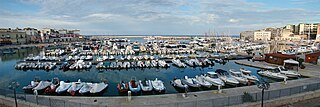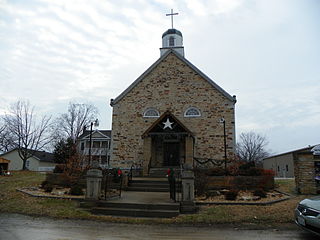
Servius, distinguished as Servius the Grammarian, was a late fourth-century and early fifth-century grammarian. He earned a contemporary reputation as the most learned man of his generation in Italy; he authored a set of commentaries on the works of Virgil. These works, In Tria Virgilii Opera Expositio, Commentarii in Virgilium, Commentarii in Vergilii Opera, or Vergilii Carmina Commentarii, constituted the first incunable to be printed at Florence, by Bernardo Cennini, in 1471.

Rabanus Maurus Magnentius, also known as Hrabanus or Rhabanus, was a Frankish Benedictine monk, theologian, poet, encyclopedist and military writer who became archbishop of Mainz in East Francia. He was the author of the encyclopaedia De rerum naturis. He also wrote treatises on education and grammar and commentaries on the Bible. He was one of the most prominent teachers and writers of the Carolingian age, and was called "Praeceptor Germaniae", or "the teacher of Germany". In the most recent edition of the Roman Martyrology, his feast is given as 4 February and he is qualified as a Saint ('sanctus').

Sergius of Radonezh was a spiritual leader and monastic reformer of medieval Russia. Together with Seraphim of Sarov, he is one of Eastern Orthodoxy's most highly venerated saints in Russia.

Sergiusand Bacchus were fourth-century Syrian Christian soldiers revered as martyrs and military saints by the Catholic, Eastern Orthodox and Oriental Orthodox Churches. Their feast day is 7 October.

The Euphrasian Basilica or the Cathedral Basilica of the Assumption of Mary is a Roman Catholic basilica in the Istrian town of Poreč, Croatia. The episcopal complex, which comprises the basilica itself, a sacristy, a baptistery and the bell tower of the nearby archbishop's palace, is an excellent example of early Byzantine architecture in the Mediterranean region.

Maurus (512–584) was the first disciple of Benedict of Nursia. He is mentioned in Gregory the Great's biography of the latter as the first oblate, offered to the monastery by his noble Roman parents as a young boy to be brought up in the monastic life.

July 26 - Eastern Orthodox Church calendar - July 28

Bisceglie is a city and municipality of 55,251 inhabitants in the province of Barletta-Andria-Trani, in the Apulia region, in southern Italy. The municipality has the fourth highest population in the province and fourteenth highest in the region.

Sergei Nikolayevich Bulgakov was a Russian Orthodox theologian, priest, philosopher, and economist. Orthodox writer and scholar David Bentley Hart has said that Bulgakov was "the greatest systematic theologian of the twentieth century." Father Sergei Bulgakov also served as a spiritual father and confessor to Mother Maria Skobtsova.

Saints Chrysanthus and Daria are saints of the Early Christian period. Their names appear in the Martyrologium Hieronymianum, an early martyrs list, and a church in their honour was built over their reputed grave in Rome.
Sergius II was Duke of Naples from 870 to 877.
Saint Sergius was a 3rd-century Roman soldier venerated as a Christian saint and martyr, almost always paired with Saint Bacchus as Saints Sergius and Bacchus.
The Fellowship of Saint Alban and Saint Sergius is a Christian ecumenical society founded in 1928 to foster contact between Christians, especially those of the Anglican and Orthodox traditions. It is named in honour of Saint Alban, the Christian protomartyr of Britain, and Saint Sergius of Radonezh, a patron saint of Russia. It publishes the periodical Sobornost and arranges an annual conference. Its headquarters are currently at Oxford in Britain, and it has branches elsewhere in Britain and in Bulgaria, Denmark, Greece, Romania, Russia and Sweden. There have also been sporadic activities in Canada and the United States.

Saints Sergius and Bacchus Church, also known as Abu Serga, in Coptic Cairo is one of the oldest Coptic Christian churches in Egypt, dating back to the 4th century.

Maurus of Parentium is the patron saint of the Istrian city of Poreč/Parenzo in Croatia, called Parentium in Roman times. He is commemorated on November 21.

Maurus of Pécs or Mór was the first known prelate who was born in the Kingdom of Hungary. He was abbot of the Benedictine Abbey of Pannonhalma between around 1029 and 1036, and bishop of Pécs from year 1036 until his death around year 1075. He wrote the Legend of Benedict of Szkalka and Andrew Zorard, two hermits who lived in the region of Nitra in modern-day Slovakia. Maurus's own cult was confirmed by Pope Pius IX in 1848.

St. Maurus Church is parish of the Roman Catholic Church in Biehle, Missouri, USA, within the deanery of Ste. Genevieve of the Archdiocese of St. Louis.

The Diocese of Bisceglie was a Roman Catholic diocese located in the town of Bisceglie on the Adriatic Sea in the province of Barletta-Andria-Trani, Apulia in southern Italy. It is five miles south of Trani.

Sergius of Samarkand, also known as Mār Sargīs or Mar Sergius, was an ascetic and missionary of the Church of the East in which he is considered a major saint. His name is associated with numerous locations in Central Asia. Not much is known about his life except that he had retreated to the Altai Mountains and,:297 according to Mari ibn Suleiman's Book of the Tower and a letter written in about 1009 by Abdishō, the Metropolitan of Merv, to Catholicos-Patriarch John V in Baghdad, Mar Sergius is responsible for the conversion of the Keraites.















